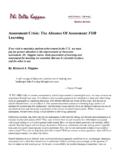Transcription of Crisis Management Briefing - Crisis Response
1 Crisis Management Briefing (CMB). When called for an intervention, the CISM team has a few options of what type of conference they will lead. The determining factors are mainly the number of participants in the intervention, and how much time has transpired since the critical stress event. When choosing which type of intervention to use, the CISM. team should abide by the following guidelines: Debriefing -takes place no more than 24-72 hours after the critical incident -usually are one to three hours in duration -involves 2-25 participants -information is drawn out from participants through interactive dialogue -follows the seven-step Mitchell model Defusing -takes place less than 12 hours after the critical incident -usually is around one hour in duration -involves 2-25 participants -information is drawn out from participants through interactive dialogue -follows an abbreviated seven-step Mitchell model Demobilization -takes place before participants leave the scene of the critical incident -usually lasts about 20 minutes -involves 2-100's of participants -information is given to the participants through a one-way announcement and education presentation -information is limited to what is known and being done currently pertaining to critical incident CMB -takes place before participants leave scene and/or up to a week after the critical
2 Incident -usually lasts between 45-75 minutes -involves 2-100's of participants in a town hall . style meeting -information is given to participants via a prepared statement from agency affected -Q&A session is focused on reactions to event;. discloses to CISM team target needs for group 1. Realize that these are mere guidelines, not concrete rules. It is very common to plan all steps and aspects of an intervention and to be thrown a curve during the session by the participants or environment. The CMB follows a four-step process that is familiar steps to CISM team members: assemble/ground rules, fact phase (information from agency affected), education phase, and resources/re-entry phase. Following the four steps, the CISM team conducts a Q&A session to further educate, inform and discuss the critical incident. Though the steps are familiar, conducting a CMB. requires much more involved interactions and evaluations by CISM-trained team members. Team members must accurately assess the group of participants at all stages of the intervention, being aware of any participants who may potentially need further care.
3 Pre-Intervention Meeting Before a CMB, it is most critical to arrive early to the meeting site to make introductions, assign positions, and get a Briefing on the incident. An ideal ratio of participants to CISM team members is four or five to each team member. This is crucial to the success of the intervention in many ways: it conveys an air of confidence to the people needing aid, it lines up beforehand the assignment of duties and positions, and it gives CISM team members a chance to associate, to get an impression of what is the nature of the problem. Assign a lead, signs &. symptoms and education positions, and a rabbit chaser (for folks who leave mid-intervention). Acquaint the team with the agency representative who will be giving the fact statement. Go over the statement to bring up any questions that can be answered ahead of time. It is advantageous to make sure the agency representative is a person whose personality is neither too shy nor too authoritative.
4 While interacting with the participants ( peer up ) as they arrive, CISM team members should be asking appropriate questions ( How do you think the group is holding up? Is it too soon or too hard to speak about the incident? ). The better prepared the team is to defining and recognizing the problems, the better the participant's return to pre-incident condition will be. Assembly/Ground Rules Make sure there are enough chairs for all the participants, plus a few extra. These should be arranged so that it encourages interaction, usually in a circle. Go over the ground rules (CISM process, out of service, no phones/pagers, confidentiality, volunteer participation, not a procedural critique), identify team members, and if possible, have participants introduce themselves (less than 20. people). Facts Phase This is an important step, as stated above, that is crucial to the CMB. The person giving the facts about the incident needs to be a representative of that agency involved.
5 This person needs to be able to dispense the facts without elaboration or opinion, and with enough authority as to be respected. It is also 2. important to interview this representative so that you can prevent them from disclosing too much information. Be aware of Management vs. labor dynamics. Participants should be told that questions would be addressed after the facts are given, but only generalities about the incident as the facts are known. This may cause undo emotional rise if particulars are brought up. Education Phase Signs & Symptoms of stress, cause and effects of prolonged exposure and impacts should be explained to the participants. Unlike the discovery phase in the conventional debriefing, participants should not be asked to compare pre- incident condition to post-incident state. Participants should be encouraged to realize their reactions are a normal Response by a normal person to an abnormal event (standard CISM methodology and vocabulary) and that the team is available for peer intervention and also can provide information about the Employee Assistance Programs available.
6 Education and handouts explaining the re-entry phase should be conveyed by CISM team members well versed in recovery techniques. This may be a good role for any mental health professionals on the team. Question & Answer Forum The floor is open to questions about the event (to be answered by the agency representative if it is a factual question), and questions as to how to deal with the stressors and effects of the event itself. The team should maintain an educational focus in their replies. After this time, team members should be available for one-on-one informal interventions, talking with participants about the event, stress Management etc. This time is key to the Crisis Management Briefing , as it gives the participants ample time to voice concerns that were not answered during the main session. Key Issues with the CMB. Pre-assign positions (education, gatekeeper, leader, etc.). Identify any mental health professionals attending If answers to pre-meeting questions are leading to the event being too close to the Briefing or it is too hard to verbalize anything about the event, go straight to the signs &.
7 Symptoms/education phase. In the assembly/ground rules phase ask if there is anyone that is uncomfortable with the participants or team members. This may keep some from sharing openly about the event. Remember to conduct a post- Briefing meeting with the team to verbalize any observations and improvements concerning the Briefing . 3.







